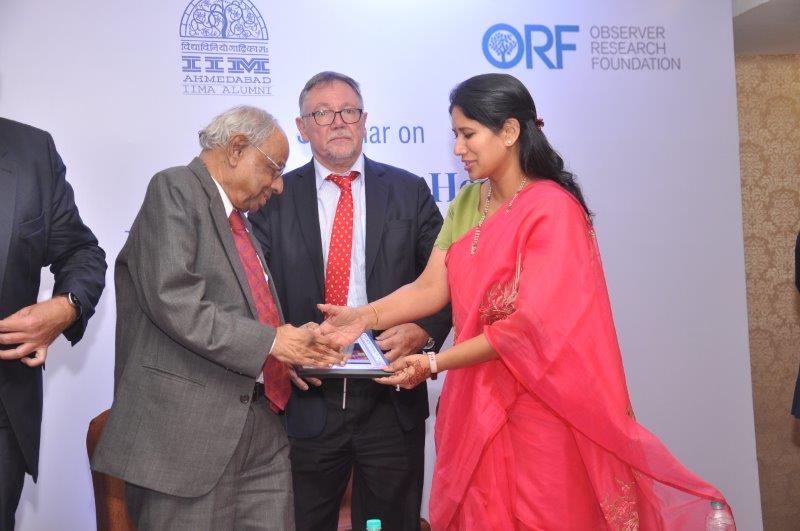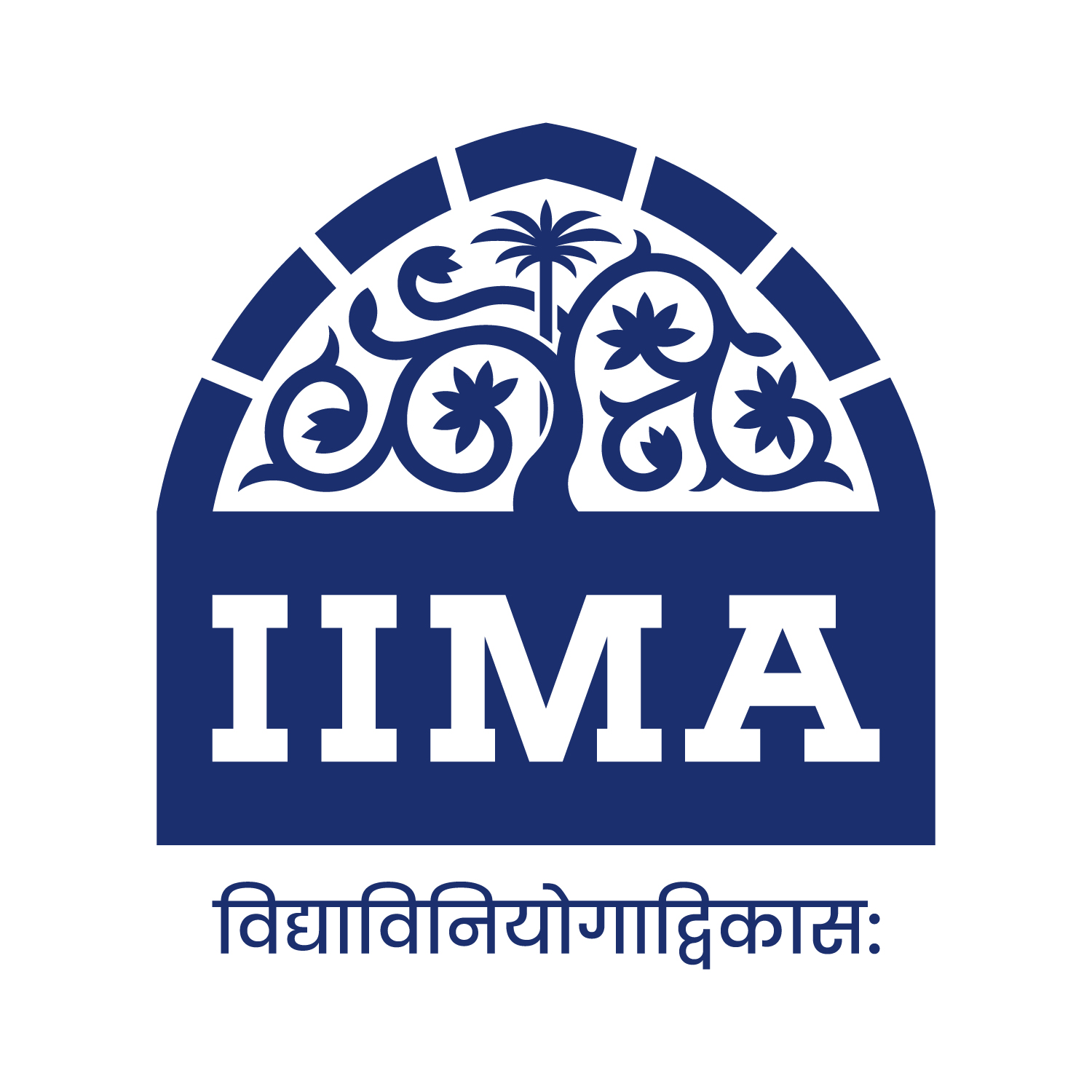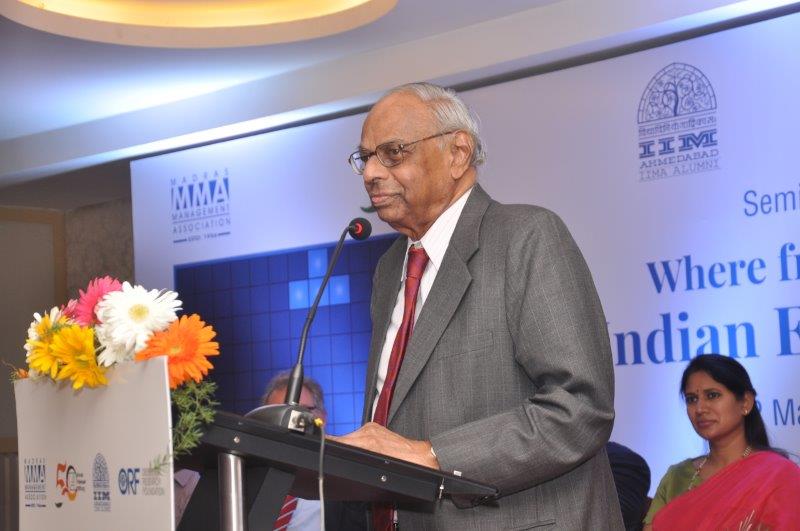Chennai Chapter: Economic Development in India – Future Directions

– MC Srikanth (PGP1983) and KC John (FPM 1988)
On Friday the March 2nd 2018, the Chennai Chapter invited Dr. C Rangarajan, Former Chairman, Economic Advisory Council to the Prime Minister, and Former Governor, RBI and current Chairman, Madras School of Economics to share his thoughts on ‘Economic Development in India: Future Directions’. The IIMA Alumni Association partnered with the Madras Management Association to host the seminar at E Hotel, Express Avenue Mall, Chennai at 6:00 PM. Over 150 IIMA Alumni and MMA members attended the seminar.
Dr. Rangarajan, who was a Professor at IIMA till 1983, successfully teleported Alumni to his classroom. He articulated complex economic challenges confronting Indian economy in simple form and emphasized the importance of evidence-based policy making and implementation. He demonstrated the adage, “You can take the teacher out of the classroom, but you can’t take the classroom out of the teacher.”
Summary of Dr. Rangarajan’s speech is excerpted below.
The year 1991 signaled a paradigm shift in India’s economic policy. The country faced an acute economic crisis triggered by a severe balance of payments problem. The crisis was converted into an opportunity to bring about fundamental shifts in India’s economic policies.
A common thread weaving together a veritable policy mix, introduced since July 1991, was improving the productivity and efficiency of the system by introducing a greater element of competition.
This was achieved by removing the entry barriers. An enabling industrial policy was put in place by dismantling wide network of controls and licenses. It increased the domestic competitiveness of the Indian industries. The foreign trade policy reforms aimed at improving the international competitiveness through gradual elimination of protective and insulating tariff structures. The private sector was offered larger space to operate by throwing open arenas reserved for the public sector. However, this did not mean a diminishing role of the state. The role of the state as the producer of marketable goods and services came down. The state assumed the role of regulator. While as a provider of public goods and services such as primary health and education, remained critical. More market did not mean less government, but different government.
The break with the past took shape in three distinct ways. First, the dismantling of the large number of controls that determined ‘what to produce’, ‘how much to produce’ and ‘where to produce’. Second, reimagining the role of the state. Third, integration of the Indian economy with the rest of the world by giving up the isolationist import substitution policy.
Any assessment of the performance of the economy, post-liberalization, should be on three criteria. These include, (i) the pace and pattern of growth; (ii) stability of the growth, and (iii) the distributional aspects of the growth process.
Pace and Pattern of Growth
Indian economy, during the first three decades after independence, grew at an average annual growth rate of 3.5 percent. India’s population was growing at 2.2 percent; the per capita income grew only at 1.3 percent. In the 1980s, the growth rates picked up. It exceeded 5 percent. But India ended up with crisis of 1991.
In the post-liberalization period, the annual average growth rate [from 1992/92 to the present] is about 6.6 percent. However, post-2000, the average annual growth rate had picked up to 9.4 percent between 2005/06 and 2007/08 and peaked at 10.26% in 2010. Thus, for the five year period – 2005/06 to 2010/11 – the annual average growth of the economy was between 8 and 9 percent.
Since 2012/13, the growth rate has fallen and that’s a matter of concern. It is true, however, that the rate of growth of the Indian economy compares very favourable with what is happening in the rest of the world. But it is certainly operating below our potential and below what our requirement is. Therefore, one of the concerns now is to escape from the slow pace of growth or relatively lower rate of growth of economy and navigate to a higher growth path. That is an issue that I would come back to a little later.
Stability Conditions The stability conditions can be viewed from three perspectives:
- Balance of Payments [BoP] Stability. India’s current account deficit [CAD] is one of the success stories of the economic liberalization and reforms processes. India went to the International Monetary Fund [IMF] five times, at periodic intervals, prior to 1991 BoP crisis. Post-liberalization, India has been able to manage the situation internally and even the 2013 fragility was resolved due to our own efforts. It is true that the low current account deficit [CAD] in the last few years was also helped by the fall in the crude oil prices. Now that the crude oil prices have shown upward trend, the CAD this year could be 2 percent of GDP, even though it has remained around 1.1 percent for the last three years.
- Price Stability. India experienced fairly high inflation rates during this period with a high CPI of 14.97 percent in 2009 and 11.17 percent in 2012. There were a few years in which it had tapered but by and large the inflations rates were high. But introduction of the New Monetary Policy Framework has brought in a substantial reduction in the inflation rate. Lower crude oil prices have significantly helped in lowering the inflation rate.
- Fiscal Stability. The maxim that “you cannot spend your way to prosperity” is now widely accepted. The FRBM mandated a fiscal consolidation and that the Centre should reduce its fiscal deficit from 3.5 percent (2017) to 2.5% percent by 2023. I would always urge that the Government be guided by that. I am not saying that there should be no flexibility. But continuously deviating from that mandate does create credibility problem. It is true that India has brought down its fiscal deficit. But we should continue to show vigilance and stay the course.
Distributional Aspect of Growth
Let me shift my focus on the distributional implications of the rate of growth of the economy. After all, the question is, who benefits from growth and the previous speaker raised issues pertaining to the skewed distribution of income and wealth as well as impact on poverty. Yes, in some sense, our development in relation to social area is perhaps not as impressive as it in in terms of growth performance. India ranks 131 out of 188 nations in terms of Human Development Index. The HDI is a measure for assessing progress in three basic dimensions of human development: a long and healthy life, access to knowledge, and access to a decent standard of living. India is placed in the ‘medium human development’ category, alongside countries such as Congo, Namibia and Pakistan. It is ranked third among the SAARC countries, behind Sri Lanka and the Maldives, both of which figure in the ‘high human development’ category
It is also true that even in relation to some of the health indicators, India’s performance, relatively speaking, is worse than some of the other countries with a lower per capita income than that of ours. But it is also true that in some indicators India’s performance has been very good. For instance, the life expectancy has improved from 33 years in 1947 to 68 years at birth, today.
Where from Here?
Growth is important. India must sustain the economy at a higher growth rate. People talk about the potential rate of growth in the economy. If you mean by the word ‘potential’, the maximum that you can achieve, then the Indian economy has demonstrated an average annual rate of growth of 8 to 9 percent. Therefore, I certainly belief that we have shown the capability and we must get back to that level of growth rate in future. Higher growth creates surpluses and resources that are required in order to improve some of the social indicators with which we are concerned. I think our immediate concern must be to end the current phase of low growth.
Rate of growth of the economy is determined by two factors, viz,, investment rate and productivity of the capital. Kaldor formulate the potential growth equation:
G = Investment Rate/Incremental Capital Output Ratio
Incremental capital output ratio [ICOR] measures the additional unit of capital required to produce one unit of output. The greater the capital required to produce one unit of output, lesser is the productivity of the capital.
India has experienced a gradual decline in investment rates and saving rates. The ratio of gross fixed capital formation to GDP climbed from 26.5 percent in 2003, reached a peak of 35.6 percent in 2007, and then slid back to 26.4 percent in 2017. This is lowest in more than a decade.
We really need to introspect and see that the pick-up in investment rate goes back to 38% and the ICOR goes back from 6:1 to 4:1 so that we clock a growth rate of 9 percent and above.
There are several things that need to be addressed in this particular context. Investment is an act of faith in the future. Therefore, we need to create that climate and sentiment for investment in the country which has both economic as well as non-economic determining factors.
The ratio of domestic saving to GDP registered a similar evolution from 29.2 percent in 2003 to a peak of 38.3 percent in 2007, before falling back to 29 percent in 2016. That is one of the reasons why the financial resources that are required to support the investment are also falling. When the investment sentiment is low, then the fall in the savings rate does not matter because the resources are not needed. But today we need to simultaneously raise the investment rates as well as the saving rates.
True! The problem with the banking system is an issue but we need to resolve that particular problem. There is an old saying in banking which says, ‘bad loans are sold in good times’. This is because everything looks optimistic during boom period and every project is grabbed. The non-performing assets are a result of business cycle where capacity building during boom time invited laxity in lending. It took many years for the capacity to be fully utilized and I hear even now from the industry people that the capacity utilization is still less than 80 percent. Therefore, the problem needs to be resolved.
Structural Changes
Issues relating to industry needs to be looked at properly. The earlier speaker raised the question about the structural changes and the gradual shift of the role of primary and secondary sectors. For instance, in the United States, agriculture constitutes about 3 to 5 percent of the GDP. In India the dominant primary sector has been substituted by the tertiary sector – services – and skipped a phase of growth and development. But that is also a reflection of what is described as industry before are now treated as service. Earlier, the manufacturer did everything, from downstream supply chain management to the upstream packaging, which constituted an integral part of the manufacturing. However, growing specialization and differentiation led to some of these activities being performed by services partners. This is happening all over the world and it is not something very peculiar to India.
However, I think that we need to specially address the problems of the agricultural sector in India. Because, the Indian structural transformation from agricultural sector to the service-led growth has not brought about a similar structural shift in the total employment or the livelihood of the population. The faster growth of income producing services was skill-intensive and urban-centric. Rural India continues to remain dependent on the agriculture even though the share of agriculture has come down.
In the agricultural sector, we need a transparent pricing mechanism. The recent agrarian crises are not due to the lack of production but because of the fall in prices. That means, production has increased and the economy is so balanced that even a small increase in production results in fall in prices. I would suggest that the Government should intervene and procure the excess supply over normal so that market mechanism will self-correct and bring the prices to the appropriate levels. Therefore, we really need to stay the course of the reform process that begun in 1991 and continue to improve overall competitiveness of the economy. But at the same time, it needs to be balanced with appropriate state interventions.
Let me address the challenges of job creation. It is not something independent of the rate of growth of the economy. The rate of the growth of the economy and the job creation are more or less synonymous. I would, though, qualify that the job creating potential depends on the pattern of the growth of the economy vis-à-vis the rate of the growth. Growth at a particular point in time can happen because of the new investment or better utilization of the existing investment. Whatever growth that we have seen today in India is the result of the better utilization of capacity. Job creation is directly correlated with the new investment.
Some of the recent changes in the insurance, FDI reforms and also the GST are important. GST implementation creates certain tension because it is a fundamental change as far as the Indian taxation is concerned. All countries that introduced GST have gone through a difficult period of transition. We should review the Indian economy and identify areas to improve competitiveness.
Let me focus my attention on poverty. Simon Kuznets in the 1950s talked about the concomitant rise of inequality in the early period of development. The income data in India is very doubtful. The only reliable data is the consumption expenditure through the National Sample Survey and analysis of the consumption expenditure does not show any substantial increase in inequality. However, there is a greater inequality in wealth because that is part of legacy. In fact, the performance of the economy in terms of the social development should include an assessment of poverty ration and see how it has been behaving. Poverty can be defined in a number of ways. Many government appointed committees have looked into the matter in terms of the minimum calorie requirements and the consumption expenditure that is required to meet the calorie needs. There is enough evidence to show that the poverty ratio comes down much faster during the period of rapid economic growth. Both Tendulkar method and the method suggested by a committee chaired by me, provided more or less the same numbers. I would suggest that we need to look at some concept like a poverty ratio, trace its phenomenon, rather than looking at the inequality co-efficient and so on. We also found that bulk of the people who are around the poverty line or below the poverty line and therefore any attempt to bring down the poverty ratio would be most apposite.
The National Health Care Scheme proposed in the Union Budget is a significant change in the right direction. Unfortunately, the Budget lacks details. It is not very clear how this is going to be brought about. It says it will cover 10 crore families which means about 50 crore individuals. We do not know whether it is the insurance scheme or public health that will provide the facilities. We need to look at both the cost of universal health assurance as well as the health care infrastructure to provide universal health coverage.
Let me conclude. In many ways, the coming decade will be very crucial for India. If only India grows at 8 to 9 percent per annum, India’s per capita income will grow from the current level of $1600 to $8000 by 2030. Growth is important because it is the answer to many of our socio-economic problems. Many of the social safety net programs that we organized in the recent period – the Rural Employment Guarantee Scheme, National Rural Health mission and Extended Food Security, etc., – were made possible at a time when the economy was growing faster. We need a two-fold approach – let the economy grow fast and utilizing the surpluses to address the problems of the vulnerable and disadvantaged sections of the population.
Development has many dimensions. It has to be inclusive. It must lead to reduction of poverty. It must be environment friendly. All these needs to be built into the growth process. But growth is critical. Reforms are not ends in themselves. Even growth is not an end in itself. Growth triggered by reforms must be shared by all. Equity and efficiency should not be framed as one against another. These should be viewed in a framework of development where growth is accompanied by equity. There lies, if I may say so, economic development. Thank you very much.




Sorry, the comment form is closed at this time.